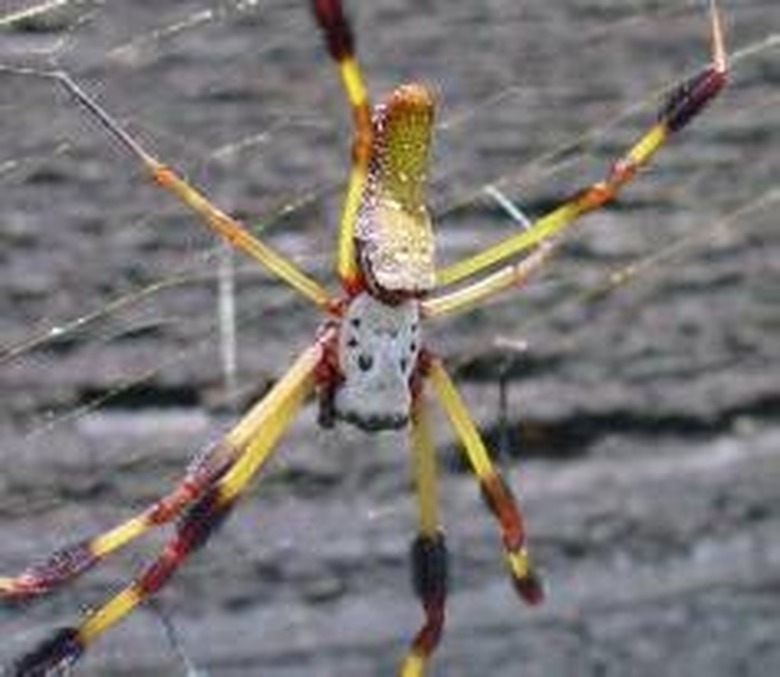About The Banana Spider
Various urban myths say that a banana spider can lay eggs inside a banana fruit, and if someone unknowingly peels it from the wrong end they will eat the spider eggs and something bad will happen to them. Rest assured that this isn't true! More often the case is that spiders have been found hiding in bunches of bananas, which are then transported to markets – but even this is quite rare. The name of the spider in question refers to the spider also known as the golden silk or golden orb weaver (Trichonephila clavipes).
Banana Spider Appearance
Banana Spider Appearance
Banana spiders get their name from the bright yellow bands that appear on the female's legs, which are intermixed with dull orange and dark patches of hairy bands. Her abdomen is usually a yellow or orange-brown color and her cephalothorax, the upper half of her body, is silvery. The female is large, measuring between 20 and 40 millimeters long.
Male banana spiders are less distinct. They have a dark brown body with light brown legs. The males are also tiny compared to the females, measuring less than six millimeters long.
Banana Spider Bites
Banana Spider Bites
Banana spiders make large webs to catch small flying insects like grasshoppers and flies. When the insect gets tangled in the net the spider feels the vibrations run through the web. The spider rushes out and bites their prey, injecting them with a venom that subdues them and prevents escape.
While banana spider bites are deadly to their prey, they're generally harmless to humans. A bite from one of these spiders is described as feeling less painful than a bee sting. The area will redden at first then heal. Banana spiders are not aggressive to humans, and they will only bite for defense when they are picked up or pinched.
Banana Spider Habitats
Banana Spider Habitats
In their most northern range, banana spiders are found throughout the southern regions of the United States. Their range extends as far south as Argentina and Peru. Banana spiders are widespread in warm areas like Florida and Puerto Rico.
Banana spiders make large webs reaching between three and seven feet wide. Because they survive by catching flying insects to eat, their fine webs are usually found strung between trees in open forest areas. Their webs are often spotted along hiking trails, at the edges of forest clearings and over waterways. The spider can be spotted waiting for prey and mates near the top of her web.
How Do Banana Spiders Reproduce?
How Do Banana Spiders Reproduce?
Spiders have an incomplete metamorphosis developmental cycle. This means that after hatching from their eggs, spiders look like miniature versions of the adults. Because their outer skin-like layer (called an exoskeleton) is hard, it doesn't grow as the spider grows, and they must shed it through a process called molting. Spiders molt periodically throughout their lives until they become fully-grown adults.
After her final molt, a female banana spider will be fertile and able to mate for 48 hours. Male banana spiders find females in their last molt stages. He then patiently waits on her web, guarding her against other males until they can mate. After mating, the male will look for another female. The female will lay at least two silk-covered egg sacs measuring about one inch long, each containing several hundred eggs.
Web Thieves: Kleptoparasitic Spiders
Web Thieves: Kleptoparasitic Spiders
Sometimes portions of banana spiders' webs are stolen by small kleptoparasitic spiders of the genus Argyrodes. These small spiders cut out a 1.5-inch diameter section of the host's web and run away with it. The robber spider then eats the web and any small insects stuck inside it. These spiders rarely make webs of their own.
Having their web stolen is a problem for banana spiders for two reasons. Firstly, before making new webs the banana spider eats its existing web to recycle the nutrients for web building. If parts of its web have been stolen, the spider loses these nutrients. Secondly, the holes created by web theft makes the webs less effective and forces the banana spider to expend valuable energy in fixing them. If kleptoparasitic spiders become a continual nuisance for the banana spider, it may set off and find a new location to build a new web.
Cite This Article
MLA
Jerrett, Adrianne. "About The Banana Spider" sciencing.com, https://www.sciencing.com/about-the-banana-spider-12146070/. 30 September 2021.
APA
Jerrett, Adrianne. (2021, September 30). About The Banana Spider. sciencing.com. Retrieved from https://www.sciencing.com/about-the-banana-spider-12146070/
Chicago
Jerrett, Adrianne. About The Banana Spider last modified March 24, 2022. https://www.sciencing.com/about-the-banana-spider-12146070/
